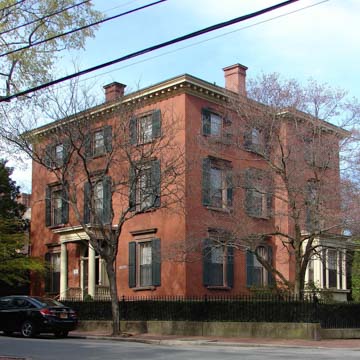Alpheus Morse excelled in combining the palazzo and villa forms into ample detached Italianate houses. In the William Binney House the symmetrical three-bay facade, restrained and elegant, holds the front; but the massing appropriately erodes picturesquely on the garden side. The formula proved especially useful for College Hill.
More than proximity relates the other two Italianate houses. The Almy House, for an important early nineteenth-century cotton manufacturer and his sister, bears a strong resemblance in form and plan to an 1852 design by Thomas Tefft for Smith Owen. Hence the attribution, although the house was built three years after Tefft left Providence for a lengthy European sojourn, where he died in Florence in 1859 of typhoid. (Was the design adapted by a builder? If so, how did Almy belatedly come to build a design originally intended for Owen?) The mansard roof may be a later addition, but the combination of mansard roof and flushboard siding typifies early examples of the Second Empire. When Owen, a prominent jeweler, eventually did build his house, after Tefft's death, he turned to Morse. Like the Binney House, the Owen House has a rigidly symmetrical Italianate facade, whereas the massing becomes irregular toward the garden side.




















